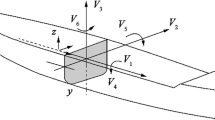Abstract
Autonomous Underwater Helicopter (AUH) is a novel dish-shaped multi-functional submersible vehicle in the autonomous underwater vehicle (AUV) family. Numerical study of launch and recovery system for AUVs from a research vessel is significant in the overall design. Single-arm crane and air-launch way are the important ways of launching AUVs with the high expertise and security. However, AUVs are still easily subject to a huge impact load which can cause the body damage, malfunction of electronic components, and other serious accidents when AUVs are launching into water. In this paper, unsteady, incompressible, two-phase flow with identified boundary conditions was modeled in the computational domain using Volume of Fluid (VOF) technology, and different overset-grid sizes were set and analyzed to ascertain the accuracy of computational fluid dynamics (CFD) simulation first due to the setting of the grid which will directly affect the accuracy of the calculation results, especially the overset-grid convergence validation. Then, the change of water-entry impact force and velocity of AUH with different water-entry velocities and angles were calculated by CFD analysis software STAR-CCM + solver. The proper immersion angle of the AUH should be 75° under comprehensive analysis and comparison. Besides, the variations of pressure distribution of the AUH in the whole water-entry process were also obtained, which provides reference for the shape optimization in the future work.


















Similar content being viewed by others
References
Yamazaki T (2009) Status of development for deep-sea mineral resources. J Jpn Inst Energy 88(7):569–576
Leonard JJ, Bahr A (2010) Autonomous underwater vehicle navigation. Ocean Eng 35(3):663–678
Yi R, Hu Z, Lin Y, et al (2013) Maneuverability design and analysis of an autonomous underwater vehicle for deep-sea hydrothermal plume survey. Oceans 1–5
Woolsey Craig A (2005) Review of marine control systems: guidance, navigation, and control of ships, rigs and underwater vehicles. J Guidance Control Dyn 28(3):574–575
Phillips AB, Turnock SR, Furlong M (2010) The use of computational fluid dynamics to aid cost-effective hydrodynamic design of autonomous underwater vehicles. Proc Inst Mech Eng Part 224(M4):1–16
Feng Z, Chen CW, Yu Z, Huang H, Su H, Leng JX, Chen Y (2018) Hydrodynamics performance analysis of underwater helicopter based on STAR-CCM+. 2018 OCEANS-MTS/IEEE Kobe Techno-Oceans.
Chen Q, Su R (2011) Analysis of launch and recovery UUV model for submarine. Ship Sci Technol 33(7):146–149
Zhang HL, Deng ZY, Luo YG (2012) Development actuality of submarine launch and recovery system. Ship Sci Technol 34(3):3–6
Sarda EI, Dhanak MR (2017) A USV-based automated launch and recovery system for AUVs. IEEE J Oceanic Eng 42(1):37–55
Zhang H, Deng Z, Luo Y (2012) Development actuality of submarine launch and recovery system. SHIP Sci Technol 34(4):3–6
Wang Y, Shi X, Wang P (2008) Modeling and simulation of oblique water-entry of disk Ogive. Torpedo Technol 16(01):14–17
Qiu HQ, Yuan XL, Wang YD, Liu CL (2013) Simulation on impact load and cavity shape in high speed vertical water entry for an axisymmetric body. Torpedo Technol 21(03):161–164
Shi Y, Pan G, Huang QG (2017) Water entry impact cushioning performance of mitigator for AUV. Oceans 2017-Aberdeen. IEEE, p 1–5
Ma QP, He CT, Wang C, Wei YJ, Lu ZL, Sun J (2014) Experimental investigation on vertical water-entry cavity of sphere. Explos Shock Waves 34:174–180
Qi D, Feng J, Xu B et al (2016) Investigation of water entry impact forces on airborne-launched AUVs. Eng Appl Comput Fluid Mech 10(1):475–486
Shan Wang C (2014) Guedes Soares, Numerical study on the water impact of 3D bodies by an explicit finite element method. Ocean Eng 78:P73–88
Sodja J (2007) Turbulence models in CFD. University of Ljubljana, Ljubljana, pp 1–18
Henshaw WD, Schwendeman DW (2003) An adaptive numerical scheme for high-speed reactive flow on overlapping grids. J Comput Phys 191(2):420–447
Liu Y-P, Ouyang C-Z, Jiang Q-B, Liang Bo (2015) Design and parametric optimization of thermal management of lithium-ion battery module with reciprocating air-flow. J Cent S Univ 22:10 (P3970–P3976)
Nova Science Publishers (2009) Multiphase flow research. Nova Science Publishers, New York
Lafmejani SS, Olesen AC, Kær SK (2017) VOF modelling of gas–liquid flow in PEM water electrolysis cell micro-channels. Int J Hydrog Energy 42(26):16333–16344
Singh RK et al (2018) Multiphase flow studies for microscale hydrodynamics in the structured packed column. Chem Eng J 353:949–963
Nouri NM, Zeinali M, Jahangardy Y (2016) AUV hull shape design based on desired pressure distribution. J Mar Sci Technol 21(2):203–215
Sodja J (2007) Turbulence models in CFD. University of Ljubljana
Sakthivel R, Vengadesan S, Bhattacharyya S K (2011) Application of non-linear k-e turbulence model in flow simulation over underwater axisymmetric hull at higher angle of attack. J Naval Archit Marine Engineering 8(2)
Nematollahi A, Dadvand A, Dawoodian M (2015) An axisymmetric underwater vehicle-free surface interaction: A numerical study. Ocean Eng 96:205–214
Hirt CW, Nichols BD (1981) Volume of fluid (VOF) method for the dynamics of free boundaries. J Comput Phys 39(1):201–225
Chow P, Cross M, Pericleous K (1996) A natural extension of the conventional finite volume method into polygonal unstructured meshes for CFD application. Appl Math Model 20(2):170–183
Acknowledgements
The authors wish to thank the national key special research plan of the China Ministry of Education and the National Natural Science Foundation of China and Zhoushan Science and Technology and the Strategic Priority Research Program of the Chinese Academy of Sciences for their financial support of this research under the project Grant numbers: 2017YFC0306100, 51409230, 2018C81041, and XDA22000000.
Author information
Authors and Affiliations
Corresponding author
Additional information
Publisher's Note
Springer Nature remains neutral with regard to jurisdictional claims in published maps and institutional affiliations.
About this article
Cite this article
Chen, CW., Wang, T., Feng, Z. et al. Simulation research on water-entry impact force of an autonomous underwater helicopter. J Mar Sci Technol 25, 1166–1181 (2020). https://doi.org/10.1007/s00773-020-00707-8
Received:
Accepted:
Published:
Issue Date:
DOI: https://doi.org/10.1007/s00773-020-00707-8




